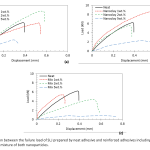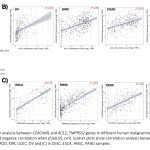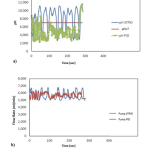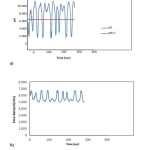| Title | Pages |
|---|---|
| Evaluation Of The Antimicrobial And Cytotoxic Activities Of Some Amino Acid Methyl Esters In this study, the antimicrobial and cytotoxic activities of some amino acid methyl esters (L-methionine methyl ester, L-phenylalanine methyl ester, L-histidine methyl ester, L-lysine methyl ester, L-tryptophan methyl ester, and L-tyrosine methyl ester) were investigated. The antimicrobial effects of amino acid methyl esters were evaluated against Gram-negative and Gram-positive bacteria. The effect of amino acid methyl esters on cell viability was also investigated against cancerous and non-cancerous cell lines using the MTS method. The results showed the substances had low antimicrobial effect on both Gram-negative and Gram-positive bacteria. In addition, it was determined that the studied substances did not have a toxic effect on non-cancerous cells. For this reason, it is thought that the results obtained will contribute to research on new synthesizable compounds based on amino acid esters and studies on drug development. 


|
133 - 140 |
| Enhanced Petroleum Removal by Potent Biosurfactant Producer Bacillus Subtilis CC9 Strain Isolated from an Oil Field This study aimed to enhance the removal of petroleum with potent biosurfactant producing bacterial strains (Bacillius subtilis CC9, Enterobacter asburiae WMB1, Klebsiella oxytoca Rizhao 536-1, and Acinetobacter pittii PgBE252) isolated from an oil field. The biosurfactant production was determined by different screening methods such as hemolytic activity, drop-collapse, oil-spreading, BATH, emulsification index and surface tension. While the presence of biosurfactant was detected with individual bacterial strain, B. subtilis CC9 strain was found to be quite effective on petroleum degradation (92%) with a high yield of biosurfactant production (0.95 ±0.05 g L-1). The degradation rate constant and half-life period of B. subtilis CC9 strain were calculated as K = 2.533 day−1, t1/2 = 0.273. It has been clearly shown with GC/MS analysis that B. subtilis CC9 strain was effective on the removal of long chain n-alkanes (C31 - C35) as well as short and medium chains. The FT-IR analysis also approved the presence of aliphatic and peptide moieties of biosurfactant extracted from B. subtilis CC9 strain. It is remarkably pointed out with this study that high yield of biosurfactant producing B. subtilis CC9 strain can be used in advanced petroleum bioremediation studies as an alternative to chemical surfactants. 



|
141 - 152 |
| Effects of Silica/Clay Nanoparticles on Microstructural and Mechanical Properties of Epoxy Based Adhesives Improving the mechanical properties of the epoxy-based adhesives with nanoparticles is one of the methods which justifies the use of adhesive joints. This work studies the strength of adhesively bonded single-lap joints (SLJs) considering the pure adhesive, the reinforced adhesive with nano-silica particles (NSPs), nano-clay particles (NCPs), and a combination of both nano particles. Uniaxial tensile testing of the SLJs was conducted to reveal the failure loads of the joints and their elongations at failure. Furthermore, Scanning electron microscope (SEM) images and X-ray Diffraction (XRD) Analyses were used to investigate dispersion quality. It was observed that the use of just 1 wt.% NCPs or 2 wt.% NSPs significantly improve the failure load by 48% and 44%, respectively; whereas the combination of both particles generally leads to large agglomerations. These agglomerations lead to 86.5% failure load reduction. It is also concluded that the dispersion quality is a key to improving the strength by shifting the failure mechanism from adhesion to cohesion type. 



|
153 - 161 |
| Chitosan Films Prepared With Low Nanometal Content for Developing Protective Denim Fabrics At this study; Chitosan was obtained from crayfish and identified by X-ray diffraction (XRD), molecular weight and elemental analyses. Later, it was coated on fabrics alone and in combination with nano-metal. The protective properties of the coated fabrics was investigated by UV protection and antibacterial analyses. Crayfish chitosan had low crystallinity (72%), low molecular weight (Mw) (11.2 kDa) and low degree of deacetylation (DD) (16%). When used together, nano TiO2 reduced the UV protection of the crayfish chitosan in both dyed and undyed denim fabrics. Chitosan+nano Ag coated fabric had the highest antibacterial activity (Antibacterial activity value (A): 4.27) against Staphylococcus aureus while chitosan+nano TiO2 coated fabric did not show any antibacterial efficiency (A: 1.89). After washed, the chitosan coated and the chitosan+nano Ag coated fabrics retained their antibacterial efficiency. 



|
163 - 181 |
| Programmable Living Nanorobots There are many different nanorobots in the literature, but the nanorobots that we will talk about in this review is a unique robot and the first of their kind because it is made entirely from the heart and skin cells of a frog, which means only living cells without any artificial materials. This type of robot has been programmed and studied using the silico system, in which the heart and skin cells will be arranged before being applied in vivo have been designed. On the other hand, this robot has many negatives, like anything in our world has disadvantages and advantages, so we will mention them and discuss them in this review by mentioning the aspirations and future directions of this unique robot. 


|
183 - 190 |
| Investigation of Electrochemical Properties of Uric Acid at Carbon Paste Electrode with Aluminium Oxide Nanoparticles and Development of Voltammetric Method for its Determination in Serum The electrochemical effects of uric acid (UA) were determined by cyclic voltammetry (CV), and square wave voltammetry (SWV) at a carbon paste electrode modified with aluminum oxide nanoparticles (Al2O3NP/CPE) in 0.05 M phosphate buffer (pH 5.0). The adsorption properties of the molecule on Al2O3NP/CPE were studied, and the electrons assigned in the electrode reaction were calculated. A new procedure for the quantification of UA in human serum has also been proposed. The linear operating range, and limit of detection (LOD) of the method were calculated as 0.1μM-230 μM, and 0.1μM, respectively. The developed method for UA in serum showed high reliability, repeatability, accuracy, and precision. 



|
191 - 200 |
| A Practical and Single-Use ITO-Pet Based Immunosensing Platform for Detection of Tumor Necrosis Factor-Alpha Biomarker This investigation displays a novel, practical indium tin oxide- polyethylene terephthalate (ITO-PET) based electrochemical biosensor for the Tumor Necrosis Factor-alpha (TNFα) biomarker determination. The ITO-PET electrode is a very advantageous preferred semiconductive electrode material. It has a lot of great features such as easy to prepare, cheapness, flexibility, stability. It also allows determining an analyte at very low concentrations and provides a great wide concentration range for analyte analysis. Electrochemical Impedance Spectroscopy (EIS) and Cyclic Voltammetry (CV) were used for the evaluation of biosensors, including the immobilization procedure, the investigation of the optimum conditions, and the characterization of biosensors. The immunosensor's electrode surface morphology during the immobilization process was observed using a Scanning Electron Microscope (SEM). In addition, Impedance measurement at a single frequency was used to characterize anti-TNFα and TNFα interactions (SFI). The clinical effectiveness of the developed biosensor was investigated by testing it with real human serum samples. Moreover, the fabricated immunosensor presents long shelf life, analysis of the antigen concentrations at picogram level (0.02 pg mL-1 -2.56 pg mL-1), reproducibility, reusability and high sensitivity. 



|
201 - 214 |
| Integrative Profiling of CEACAM1 in Different Malignancies with Implications on the SARS-CoV-2 Infection Genes ACE2 and TMPRSS2 Increasing number of evidence demonstrated increased SARS-CoV-2 infection risk in cancer. Despite various studies shed light on SARS-CoV-2 mediated pathways upregulated in cancer, there is still ongoing efforts to reveal underlying mechanisms of elevated risk for COVID-19 disease in cancer. Given critical role of CEACAM1 in immune exhaustion and immune deregulation observed both in cancer and COVID-19, systematic characterization of CEACAM1 in different malignancies was performed with an ultimate aim to identify the involvement of CEACAM1 in enhanced COVID-19 susceptibility in cancer patients. Here we show that CEACAM1 expression was upregulated in a number of TCGA samples. In addition, CEACAM1 expression was positively correlated with SARS-CoV-2 infection genes in TCGA samples. Single-cell RNA sequencing analysis results of COVID-19 positive patients indicated upregulation of CEACAM1 expression. Furthermore, CEACAM1 expression was associated with HAVCR2, an immune checkpoint marker, and there was a correlation between CEACAM1 and HAVCR2 levels in different TCGA samples. Collectively, CEACAM1 might provide increased susceptibility of COVID-19 disease in cancer patients which might be explained with its interaction with HAVCR2. 



|
215 - 225 |
| Self-Tuning PID (STPID) Control Of pH in Recovering Process of Magnesium Hydroxide (MG(OH)2) by Coagulatıon from Salt The salt obtained from the salt sources are not desirable purity level and contains some impurities. In the scope of this study, coagulation of magnesium hydroxide (Mg(OH)2) in pH control has been carried out by adding sodium hydroxide (NaOH) to magnesium chloride (MgCl2) and by this way recovery process has been achieved by Self Tuning PID Control. To provide the best coagulation pH 11 has been obtained as optimum pH value in consideration of the performed calculations. 



|
227 - 239 |
| Thermal and Flocculation Properties of Acacia Gum Grafted with Cationic Polyacrylamide The cationic flocculants have better flocculation ability as they can work efficiently through both bridging and charge neutralization. Acacia gum, which has common advantages such as renewability, biodegradability, non-toxicity and bio-compatibility, was grafted with cationic acrylamide to obtain a cationic graft copolymers. Acacia gum (AG) was grafted with polyacrylamides with different catonic ratios obtained by using different amounts of acrylamide (AM) and 2-(Acryloyloxy) ethyl]trimethylammonium chloride (DMC (cationic monomer)). Graft copolymers of acacia gum and monomers has been synthesized by free radical polymerization using an ammonium persulfate (APS)-ascorbic acid (AA) redox initiation system in an inert atmosphere. The thermal properties of these graft copolymers were investigated by differential scanning calorimetry (DSC) and thermogravimetric (TGA) analyses. The formation of graft copolymers was confirmed by FTIR spectroscopy and thermal analysis. The effects of different cationic ratios of polyacrylamide on flocculation and their flocculation performance were evaluated in kaolin suspension. In this study, flocculation experimental results with different dosages and different graft copolymers showed that the amount of cationic monomer in graft copolymers is effective on flocculation. 



|
241 - 249 |